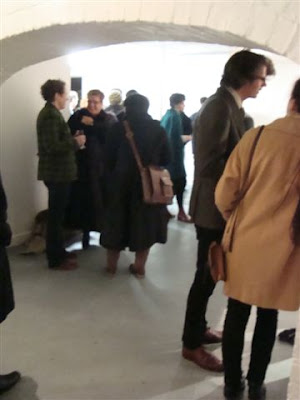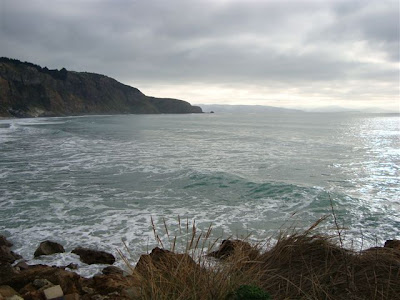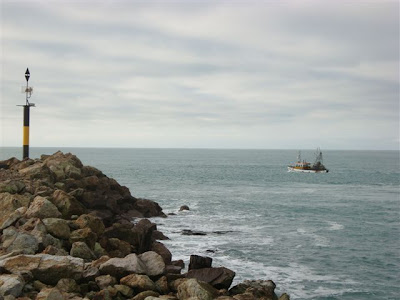The Way the Future Was. Ever since I first came across it, I've felt that the title of Frederick Pohl's mid-career memoir summed up the field of Science Fiction pretty exactly.
For all its emphasis on futuristic prediction and the pending triumphs of technology, SF (whether you read that acronym as "Science Fiction" or the more inclusive "Speculative Fiction") has always been an intensely nostalgic genre.
You feel it the moment you walk in the door of Other Worlds, the latest exhibition in the Rare Books Room at Auckland's Central City Library, an exploration of the "imaginative worlds of science fiction ... featuring books, magazines, comics and posters from Auckland Libraries Heritage Collections."
The curators' decision to focus on old SF magazine covers to create an immediate visual effect was an inspired one. The exuberance and inventiveness of the artists who illustrated these old pulp magazines was propelled not so much by aesthetic considerations as by the sheer strength of the competition.
They had to stand out against all the other possibilities on the newstand: the toney, uptown slicks; the plethora of True Crime and True Detective titles; and even the last few remaining shockers: the EC horror comics or Weird Tales - almost all of them equally attractive (or garish, depending on your taste).
And yet, look at this cover from the original run of Dune in Analog in the early 1960s. Has there ever been a more majestic rendition of a Sandworm in any of the subsequent book-covers or movies?
"Shai Hulud!" I found myself intoning as I saw it, "Bless the Maker and His water. May His passage cleanse the world." I am, as you may have gathered, an abject fan of the grandeur of Frank Herbert's conception, ever since I first read it more years ago than I care to mention ...
That's not all you see when you first go in, though. In accordance with that sense of nostalgia I mentioned above, there was an old flickering black-and-white movie being projected on the back wall: possibly the greatest SF movie ever made - certainly among the most influential - Fritz Lang's Metropolis.
It's a masterpiece no matter which version you watch it in (there are many - of varying lengths and degrees of completeness). It's probably a relic of having come of age in the 1980s, but I still can't get past the experience of first seeing it in full in the 1984 version scored by Giorgio Moroder.
Moroder colourised the scenes, which might sound sacrilegious if you didn't realise that that was how feature films were generally projected in the 1920s - just like those classical marble nudes we admire so much which were originally covered in brightly coloured paint by their creators.
Check it out for yourself at the youtube link above.
Which brings me to my next point. What exactly are we intended to take away from this assemblage of artefacts? Once you've got over the security blanket feeling of seeing so many old friends among the books displayed in the vitrines - Philip K. Dick, William Gibson, Ursula K. Le Guin, Mary Shelley's Frankenstein - you begin to wonder about the rationale behind them.
Of course the standard themes are gestured towards: Robots and Monsters, Inner Worlds, the planet Mars ... these are a few of the labels included in the exhibition brochure. And, yes, artificial life and artificial intelligence are now subjects which impact on us everyday, as do the consequences of ignoring the ecological warnings of earlier SF.
“It’s a celebration of the imagination of writers and artists – of imaginative literature,” says Andrew Henry, Curator of Auckland Collections, Auckland Council Libraries.
“There’s a huge variety of other worlds that these writers have created, from outer space to cyberspace. We want to invite Aucklanders to come and check out science fiction’s early beginnings and how it’s progressed since then; to consider how this might be topical in the modern day and what some of the wildest predictions of technology have been – did they get it right? Come find out!”Quite so. But in keeping with that invitation, I guess what excited me most about the show were the few, subversive signs it contained of a new lease of life for this now venerable genre.
It's not actually included in any of the vitrines, but I see that local author Gina Cole has been asked to come and speak about her work at one of the public programmes associated with the exhibition. When I first read her novel Na Viro a few years ago, I was hugely impressed by the skill with which it integrated both colonial and dystopian themes into a new construct she referred to as "Pasifikafuturism."
Building on her earlier collection Black Ice Matter (2017), Cole has expertly transposed some of the ideas behind the embattled concept of Afrofuturism to a Pacific context.
But it's the inclusion of works by Octavia Butler and that supreme maverick Samuel R. Delany in the cabinet marked "Colonisation" that gives us a possible lead towards seeing how these themes ought to stand front and centre in any consideration of the meaning of SF in Aotearoa now.
While neither of these authors felt exactly comfortable about the possible limiting implications of the term, there's no doubt that present-day Afrofuturism - and its offshoot, Africanfuturism - owe a great debt to their pioneering work in the SF genre. Nor did they shy away from controversy or cultural politics: the lifeblood of any engaged artform.
I'd like to see what's included here, then, as not so much a nostalgia-fest as a blueprint for further progress. Where do we go from here? For Gina Cole, that has meant conceiving of travel through space as the same leap into the unknown her ancestors undertook in setting out across the moana.
Or, as T. S. Eliot once said:
... the future is a faded song, a Royal Rose or a lavender spray
Of wistful regret for those who are not yet here to regret,
Pressed between yellow leaves of a book that has never been opened.
And the way up is the way down, the way forward is the way back.
- "The Dry Salvages." Four Quartets (1941)
•
For those interested in pursuing this topic, there are a number of sites you might like to check out:
- The Encyclopedia of Science Fiction
notable for its excellent essays on SF themes, as well as its individual author studies
- The Encyclopedia of Fantasy
again, an indispensable source of information on the genre
- ISFDB: The Internet Speculative Fiction Database
a constantly growing repository of mostly bibliographical information on the field
- NZSF: Essays on New Zealand Speculative Fiction
a website containing most of my own essays on the local product, from Samuel Butler to the present day
- SFFANZ: The Science Fiction and Fantasy Association of New Zealand
an invaluable resource for those wanting to explore the history of SF in New Zealand, as well as the latest developments in the field



































































